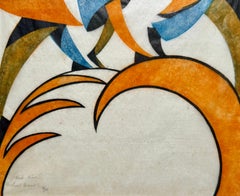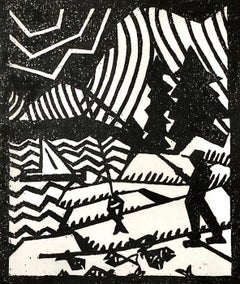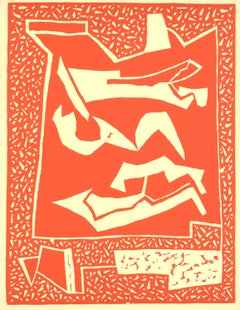Helicline Fine Art Abstract Prints
to
1
1
Overall Width
to
Overall Height
to
2
2
2
2
2
2
2
2
The New Cable British Modern Mid 20th Century Vorticist European Vorticism Woman
By Sybil Andrews
Located in New York, NY
The New Cable British Modern Mid 20th Century Vorticist European Vorticism Woman
Sybil Andrews CPE (British/Canadian, 1898-1992)
"The New Cable," 1931
12 x 16 1/2 inches
Color linocut
Signed, titled, inscribed 'Second State', and numbered 13/60 in pencil
Framed: 19 x 24 inches
Literature: Coppel Sa17
Illustrated on page 10 of the catalog
The proposed edition of the first state of the Giant Cable was 50, but only 30 impressions were pulled. Andrews removed the blue background for the second state, which was published under the title The New Cable in an edition of 60.
BIO
Sybil Andrews was a printmaker, painter, graphic artist and educator who was born in Bury St. Edmonds, Suffolk, England. She moved to London (England) in 1922. In 1947, she emigrated to Campbell River (Vancouver Island) British Columbia, Canada, where she worked, taught and lived for the rest of her life. She died at a hospital in Victoria (B.C.)
Her mediums were the colour linocut (1) (most famous), etching, posters, pastels, ink, watercolour, monoprint and oil. Her subjects were human activity (at work, sports, travel, etc.), figures, animals, genre, allegory, architecture and landscape. Her style was Art Deco (see AskART styles), Futurism, Cubism and Vorticism (2). Her work is identified by a simple format, clean lines, distortion, vivid colours, drama and rhythm.
Quote: "The colour linocut was just the medium for me, being interested in dynamics and ideas and patterns... It is impossible to be fussy with lines, you have to simplify, you are forced to simplify your idea to its fundamentals." Andrews produced 76 linocuts in her life, of which 43 were made from 1929 to 1939, which is considered to be her best period.
John Hassall's art correspondence course (1918) was the beginning of her formal art education. She went from there to Heatherley's School of Fine Art (London/1922) where she studied under Henry Massey (see AskART) and met artistic partner Cyril Power (see AskART). At the same time, she studied independently with sculptor Henri Glicenstein (see AskART) who taught her drypoint etching and to draw from life.
She also attended the Grosvenor School of Modern Art (1925). Iain McNab (1890-1967) was Principal and Claude Flight (3) (see AskART) an instructor who had a great influence on her choice of linocut as a primary medium. Some of his other students and her associates were Edith Lawrence (1890-1973), Lill Tschudi (1911-2001), Eileen Mayo (see AskART) and William Greengrass (1896-1970). After emigrating to Canada she taught art continuously until a month before her death.
She was elected a member of the Canadian Painters - Etchers Society (after 1976 the Print and Drawing Council of Canada) in 1951.
She began exhibiting her work in 1921.In 1929 she was included in "The First Exhibition of British Linocuts...
Category
1930s Modern Figurative Prints
Materials
Linocut
"Rush Hour" British Modern Mid 20th Century Vorticist European Vorticism Woman
By Sybil Andrews
Located in New York, NY
"Rush Hour" British Modern Mid 20th Century Vorticist European Vorticism Woman
Sybil Andrews CPE (British/Canadian, 1898-1992)
Rush Hour (Coppel SA 11)
Linocut printed in Chinese orange, Chinese blue and black, 1930, on tissue thin oriental laid paper.
Signed, titled and numbered 8/50 in pencil lower left, framed.
Block 209 x 251mm (8 1/4 x 9 7/8in)
Sheet 249 x 310mm (9 3/4 x 12 1/4in)
Framed by Bark 14 1/2 x 16 inches
BIO
Sybil Andrews was a printmaker, painter, graphic artist and educator who was born in Bury St. Edmonds, Suffolk, England. She moved to London (England) in 1922. In 1947, she emigrated to Campbell River (Vancouver Island) British Columbia, Canada, where she worked, taught and lived for the rest of her life. She died at a hospital in Victoria (B.C.)
Her mediums were the colour linocut (1) (most famous), etching, posters, pastels, ink, watercolour, monoprint and oil. Her subjects were human activity (at work, sports, travel, etc.), figures, animals, genre, allegory, architecture and landscape. Her style was Art Deco (see AskART styles), Futurism, Cubism and Vorticism (2). Her work is identified by a simple format, clean lines, distortion, vivid colours, drama and rhythm.
Quote: "The colour linocut was just the medium for me, being interested in dynamics and ideas and patterns... It is impossible to be fussy with lines, you have to simplify, you are forced to simplify your idea to its fundamentals." Andrews produced 76 linocuts in her life, of which 43 were made from 1929 to 1939, which is considered to be her best period.
John Hassall's art correspondence course (1918) was the beginning of her formal art education. She went from there to Heatherley's School of Fine Art (London/1922) where she studied under Henry Massey (see AskART) and met artistic partner Cyril Power (see AskART). At the same time, she studied independently with sculptor Henri Glicenstein (see AskART) who taught her drypoint etching and to draw from life.
She also attended the Grosvenor School of Modern Art (1925). Iain McNab (1890-1967) was Principal and Claude Flight (3) (see AskART) an instructor who had a great influence on her choice of linocut as a primary medium. Some of his other students and her associates were Edith Lawrence (1890-1973), Lill Tschudi (1911-2001), Eileen Mayo (see AskART) and William Greengrass...
Category
1930s Modern Figurative Prints
Materials
Linocut
Related Items
Martha Reed, (Fishing)
By Martha Reed
Located in New York, NY
Martha Reed was the daughter of the artist Doel Reed and as an adult she joined her parents in Taos, New Mexico.
There she designed clothes with a south-we...
Category
Mid-20th Century American Modern Abstract Prints
Materials
Linocut
Composition 66 (Abadie 66), Société internationale d'art XXe siècle
By Alberto Magnelli
Located in Southampton, NY
Linocut on vélin paper. Paper Size: 12.4 x 9.65 inches. Inscription: Unsigned and unnumbered, as issued. Catalogue raisonné references: Magnelli, Alberto, and Daniel Abadie. Magnelli...
Category
1930s Modern Abstract Prints
Materials
Linocut
$716 Sale Price
20% Off
H 12.4 in W 9.65 in
Sirènes (Völker 13), Société internationale d'art XXe siècle
By Henri Laurens
Located in Southampton, NY
Linocut on vélin paper. Paper Size: 9.65 x 12.4 inches. Inscription: Signed in the plate and unnumbered, as issued. Catalogue raisonné references: Völker, Brigitte, et al. Henri Laur...
Category
1930s Modern Abstract Prints
Materials
Linocut
$716 Sale Price
20% Off
H 9.65 in W 12.4 in
Huge Italian Neo Expressionist Mimmo Paladino Linoleum Block Print Atlantico
By Mimmo Paladino
Located in Surfside, FL
Mimmo Paladino
Atlantico
Linocut, 1987, hand signed, dated and numbered 12/27 in pencil.
Medium: Collagraph and linoleum cut
Sheet measures 82 x 29 1/2" inches
Parole Torchon pap...
Category
1980s Neo-Expressionist Abstract Prints
Materials
Linocut
Picasso, Tête de femme (Orozco 214), Grabados al linóleo (after)
By Pablo Picasso
Located in Southampton, NY
Linocut on vélin paper. Paper Size: 12.5 x 14.5 inches; image size: 10.5 x 8.75 inches. Inscription: Unsigned and unnumbered, as issued. Catalogue raisonné reference: Orozco, M. (201...
Category
1960s Cubist Abstract Prints
Materials
Linocut
$796 Sale Price
20% Off
H 12.5 in W 14.5 in
Huge Italian Neo Expressionist Mimmo Paladino Linoleum Block Print Atlantico
By Mimmo Paladino
Located in Surfside, FL
Mimmo Paladino
Atlantico
Linocut, 1987, hand signed, dated and numbered 12/27 in pencil.
Medium: Collagraph and linoleum cut
Sheet measures 82 x 29 1/2" inches
Parole Torchon pap...
Category
1980s Neo-Expressionist Abstract Prints
Materials
Linocut
Abstract Landscape Rajasthan Print Nature Multicultural Faces Earth Orange Brown
By Mukesh Sharma
Located in Norfolk, GB
There is a natural and raw understanding in Mukesh Sharma’s prints that depict, and are influenced by, the Rajastani communities of his home town in rura...
Category
Early 2000s Abstract Abstract Prints
Materials
Archival Ink, Archival Paper, Linocut, Archival Pigment
$1,351
H 27.56 in W 21.66 in
Huge Italian Neo Expressionist Mimmo Paladino Linoleum Block Print Atlantico
By Mimmo Paladino
Located in Surfside, FL
Mimmo Paladino
Atlantico
Linocut, 1987, hand signed, dated and numbered 12/27 in pencil.
Medium: Collagraph and linoleum cut
Sheet measures 82 x 29 1/2" inches
Parole Torchon pap...
Category
1980s Neo-Expressionist Abstract Prints
Materials
Linocut
Abstract India Edition 3/5 Linocut Print Nature Love Purple Blue Turquoise
By Mukesh Sharma
Located in Norfolk, GB
There is a natural and raw understanding in Mukesh Sharma’s prints that both depict, and are influenced by, the Rajastani communities of his home town in rural India. In these Limite...
Category
Early 2000s Abstract Abstract Prints
Materials
Archival Ink, Archival Paper, Linocut, Archival Pigment
$1,708
H 31.11 in W 21.66 in
Abstract Landscape India Edition 3/5 Linocut Print Nature Ecco of Passion Blue
By Mukesh Sharma
Located in Norfolk, GB
There is a natural and raw understanding in Mukesh Sharma’s prints that both depict, and are influenced by, the Rajastani communities of his home town in rural India. In these Limited Edition fine-art prints, made over a period of twenty years, we are offered the colours of India’s ancient land, the textures, light and the patterns that are everywhere. In the patterns of the arable fields to the jali's (carved screens) in the architecture. This work is however not romantic nor nostalgic but shows a deeper rooted need to offer a visual heritage of place, of where the artist is from and the journey that he is taking. The results are both compelling and honest.
Mukesh Sharma, Eco of Passion X, Lino-cut chin-coll’e on German Ivory paper
Edition: 3 of 5, 2005
Image size: 47 x 39 cm / Sheet size: 79 x 55 cm
Unframed
'This is life liberated, sometimes ordinary, with small gestures and everyday objects transformed by colour, context and composition and sometimes adorned, wreathed in pomp, pageantry, and glory'
Mukesh Sharma's work:
It is often in childhood that paths are set for what we will become. Mukesh Sharma hails from a rural, agricultural village in Rajasthan, India. His Father is a craftsman who fixed and mended farm machinery and understood the working parts in the processes. Sharma followed in his Father’s footsteps, as is often the case in Indian families, but his was not the machines of the fields but the presses of the printing studio.
Like his Father, Mukesh Sharma is fascinated with understanding how things work and how he can manipulate the metal in his hands. It is not surprising then that his medium of choice is printing. One of the most physically challenging of all the practices, it can often be physically challenging as well as technical and detailed.
In his youth, Sharma would draw with stones on walls and floors. He was lucky his family encouraged this and he is grateful for his early art-training at the Jaipur School of Art but it was at the Baroda Art Department that he was introduced to the great printing traditions of Jyoti Bhatt...
Category
Early 2000s Abstract Abstract Prints
Materials
Archival Ink, Archival Paper, Linocut, Archival Pigment
$1,708
H 31.11 in W 21.66 in
Mid Century French Color Lithograph "Homme au Feuillage" (Man with Foliage)
By Jean Lurçat
Located in Soquel, CA
Beautiful early 20th Century color linocut of abstracted man with leaves titled "Homme au Feuillage" (Man with Foliage) by French artist Jean Lucat (French, 1892 - 1966), circa 1950....
Category
1950s Modern Figurative Prints
Materials
Paper, Ink, Linocut
$2,800 Sale Price
20% Off
H 24 in W 20 in D 0.2 in
Abstract India Edition 5/8 Linocut Print Nature Orange Black Red Love
By Mukesh Sharma
Located in Norfolk, GB
There is a natural and raw understanding in Mukesh Sharma’s prints that both depict, and are influenced by, the Rajastani communities of his home town in rural India. In these Limited Edition fine-art prints, made over a period of twenty years, we are offered the colours of India’s ancient land, the textures, light and the patterns that are everywhere. In the patterns of the arable fields to the jali's (carved screens) in the architecture. This work is however not romantic nor nostalgic but shows a deeper rooted need to offer a visual heritage of place, of where the artist is from and the journey that he is taking. The results are both compelling and honest.
Mukesh Sharma, Voted Dyas II, Lino-cut/ chine colle, on German Ivory paper
Edition: 5 of 8, 1999
Image size: 47 x 39 cm / Sheet size: 79 x 55 cm
Unframed
'We belong where love finds us'
Mukesh Sharma's work:
It is often in childhood that paths are set for what we will become. Mukesh Sharma hails from a rural, agricultural village in Rajasthan, India. His Father is a craftsman who fixed and mended farm machinery and understood the working parts in the processes. Sharma followed in his Father’s footsteps, as is often the case in Indian families, but his was not the machines of the fields but the presses of the printing studio.
Like his Father, Mukesh Sharma is fascinated with understanding how things work and how he can manipulate the metal in his hands. It is not surprising then that his medium of choice is printing. One of the most physically challenging of all the practices, it can often be physically challenging as well as technical and detailed.
In his youth, Sharma would draw with stones on walls and floors. He was lucky his family encouraged this and he is grateful for his early art-training at the Jaipur School of Art but it was at the Baroda Art Department that he was introduced to the great printing traditions of Jyoti Bhatt...
Category
Early 2000s Abstract Abstract Prints
Materials
Archival Ink, Archival Paper, Linocut, Archival Pigment
$1,724
H 31.11 in W 21.66 in



